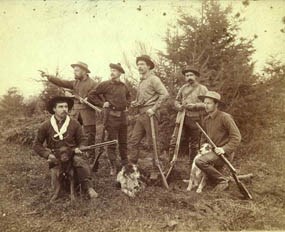|
Possibly the first European to sight the Olympic Peninsula was Juan de Fuca, a Greek pilot sailing for Spain. In 1592 he claimed discovery of the strait that now bears his name. The late 18th century saw the first well-documented voyages. In search of the Northwest Passage, the waters of the Olympic Peninsula were visited by people from various countries including Mexico, Spain, France, Russia, England, and the United States. Spanish explorer Juan Perez Hernandez sailed the coast in1774. Four years later, English navigator Captain James Cook unsuccessfully searched for Juan de Fuca's elusive strait. His countryman Captain William Barkley sailed into the strait in 1787, and named it after its discoverer. The next year another English explorer, Captain John Meares, named Mount Olympus––it seemed to him a veritable home of the gods. In 1792 the region's waters were thoroughly explored by Captain George Vancouver, who named many features including Puget Sound and Mount Rainier. Events elsewhere in North America began affecting the Olympic Peninsula in the late 1800s. Gold rushes and depressions led to movement of many young men across North America. After the California gold rush, people came to prospect the peninsula as part of the British Columbia and Klondike gold rushes. Development was limited as there were no roads at that time. Where the waters were more tranquil, canoes and small boats provided a ready means of transportation. People and commerce traveled on pack animals and across crude bridges. Though Native Americans had been long acquainted with the interior of the peninsula, Euro-American exploration of the mysterious and seemingly unknown occurred later. Several expeditions took place during the 19th century, however, it was not until the summer of 1885 that the first well documented exploration of the interior took place. Lieutenant Joseph P. O'Neil led a party of enlisted men and civilian engineers from Port Angles into the Olympic Mountains. O'Neil chose Port Angeles--at the time a town of about forty inhabitants, a hotel, a sawmill, and two stores--as his starting point because of its nearness to the mountains. On July 17, the party headed south into the foothills following a route similar to the present-day Hurricane Ridge Road, making slow progress cutting a trail through dense forest and windfalls. It took them about a month to climb to Hurricane Ridge. From there part of the group began to explore the Elwha Valley while O'Neil and the others headed southeast. O'Neil explored almost as far south as Mount Anderson before a messenger reached him with orders to report to Fort Leavenworth, Kansas, and the expedition was cut short. 
University of Washington Library, Special Collections, La Roche 10018 Another assault on the Olympic interior was made in the winter of 1889-1890. During the fall of 1889, the year Washington became a state, the Seattle Press newspaper called for "hardy citizens . . . to acquire fame by unveiling the mystery which wraps the land encircled by the snow capped Olympic range." This call was answered by James Christie, who volunteered to organize an expedition if the Press would finance it. The Press Party consisted of six men (one of them left the expedition early; five completed the trip) whom the Press described as having "an abundance of grit and manly vim," four dogs, two mules, and 1500 pounds of supplies. This group entered the Olympics in December 1889, one of the harshest and snowiest winters in the Peninsula's history. Christie had planned to follow the Elwha River into the heart of the mountains, transporting supplies on a large flat-bottomed boat, Gertie, which the men built. The boat leaked and after twelve frigid, exhausting days, it was abandoned. The party spent January - April 1890, exploring the Elwha Valley. In early May, the Press Party, their clothes in tatters and running dangerously low on supplies, crossed Low Divide and headed down the Quinault Valley, reaching the coast on May 20, 1890 after nearly six months in the mountains. Press Party blazes can still be found along the Elwha River trail in the park. |
Last updated: February 28, 2015
